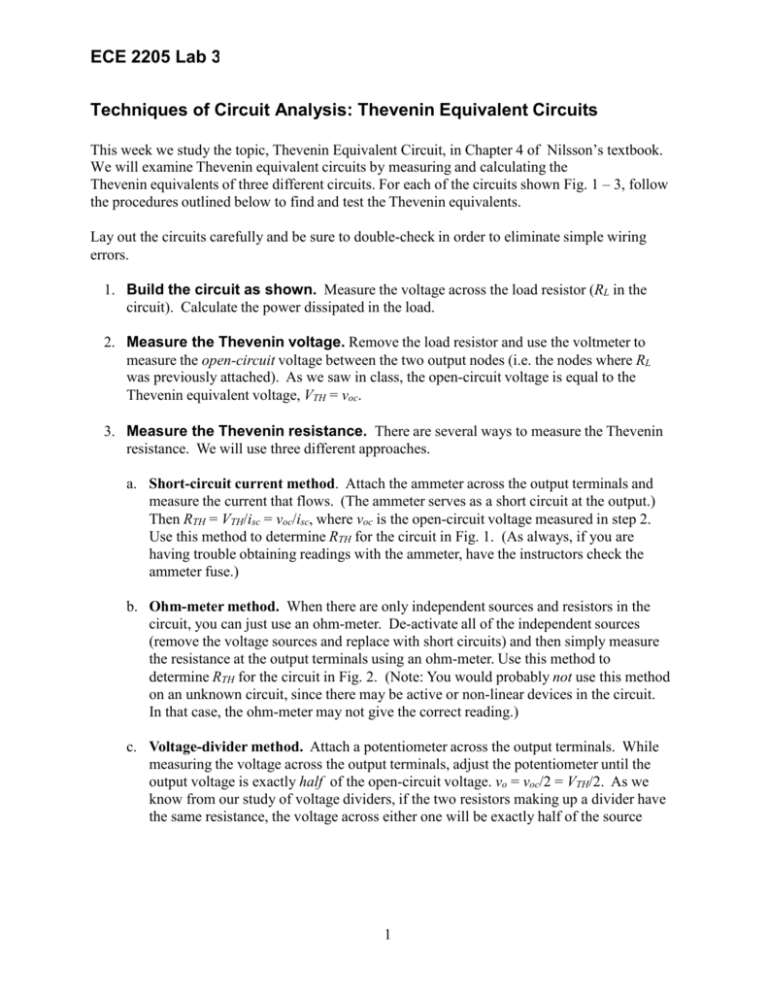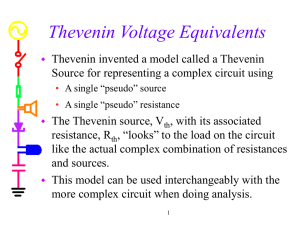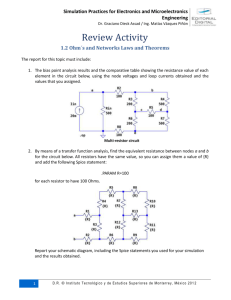lab3-thevenin
advertisement

ECE 2205 Lab 3 ! Techniques of Circuit Analysis: Thevenin Equivalent Circuits This week we study the topic, Thevenin Equivalent Circuit, in Chapter 4 of Nilsson’s textbook. We will examine Thevenin equivalent circuits by measuring and calculating the Thevenin equivalents of three different circuits. For each of the circuits shown Fig. 1 – 3, follow the procedures outlined below to find and test the Thevenin equivalents. Lay out the circuits carefully and be sure to double-check in order to eliminate simple wiring errors. 1. Build the circuit as shown. Measure the voltage across the load resistor (RL in the circuit). Calculate the power dissipated in the load. 2. Measure the Thevenin voltage. Remove the load resistor and use the voltmeter to measure the open-circuit voltage between the two output nodes (i.e. the nodes where RL was previously attached). As we saw in class, the open-circuit voltage is equal to the Thevenin equivalent voltage, VTH = voc. 3. Measure the Thevenin resistance. There are several ways to measure the Thevenin resistance. We will use three different approaches. a. Short-circuit current method. Attach the ammeter across the output terminals and measure the current that flows. (The ammeter serves as a short circuit at the output.) Then RTH = VTH/isc = voc/isc, where voc is the open-circuit voltage measured in step 2. Use this method to determine RTH for the circuit in Fig. 1. (As always, if you are having trouble obtaining readings with the ammeter, have the instructors check the ammeter fuse.) b. Ohm-meter method. When there are only independent sources and resistors in the circuit, you can just use an ohm-meter. De-activate all of the independent sources (remove the voltage sources and replace with short circuits) and then simply measure the resistance at the output terminals using an ohm-meter. Use this method to determine RTH for the circuit in Fig. 2. (Note: You would probably not use this method on an unknown circuit, since there may be active or non-linear devices in the circuit. In that case, the ohm-meter may not give the correct reading.) c. Voltage-divider method. Attach a potentiometer across the output terminals. While measuring the voltage across the output terminals, adjust the potentiometer until the output voltage is exactly half of the open-circuit voltage. vo = voc/2 = VTH/2. As we know from our study of voltage dividers, if the two resistors making up a divider have the same resistance, the voltage across either one will be exactly half of the source 1 ECE 2205 Lab 3 ! voltage. In this case, the two resistors are the Thevenin resistance of the circuit and the potentiometer. When the output voltage is exactly half the open-circuit voltage, the potentiometer resistance must be equal to the Thevenin resistance. Remove the potentiometer from the circuit (without changing the setting) and measure the resistance. Use this method to determine RTH for the circuit in Fig. 3. 4. Build the Thevenin equivalent circuit in each case using a voltage source, set to VTH, and a “resistor” equal to RTH. (The resistor can be potentiometer set to RTH or a collection of fixed resistors that combine to give RTH.) Attach the load resistor to the equivalent circuit and measure the load voltage and calculate the power. 5. Calculate the Thevenin equivalent analytically. Now use circuit analysis to calculate the values for the Thevenin equivalent circuit in each case. Use whatever technique you think is appropriate to do the analysis. You can do this before, during, or after lab, but the calculations and comparisons between your measurements and calculations must be in your report. Clean up Once you have finished all of your lab work, be sure to: put all of your components back in component bins, return all of the wires to the wire rack on the wall, turn off all of the equipment, and clean up any debris that is on your work bench. Reporting Prepare a report discussing your calculations and measurements for the four circuits. Be sure to note and comment on any differences between the calculations and measurements. The report is be due at your next lab time. 2 ECE 2205 Lab 3 ! Figure 1. Figure 2. 3 ECE 2205 Lab 3 ! Figure 3. 4 ECE 2205 Lab 3 ! 5








